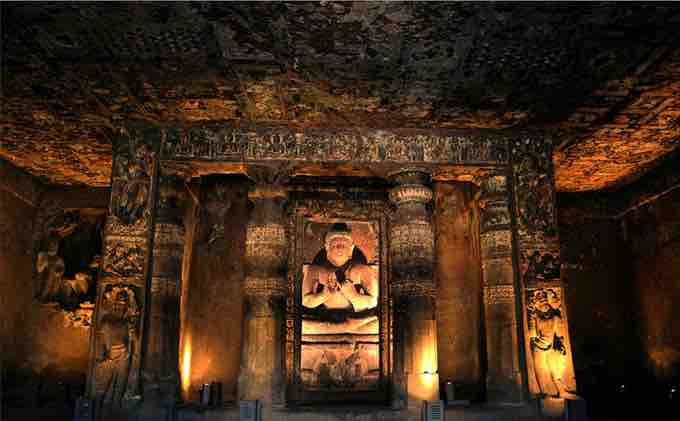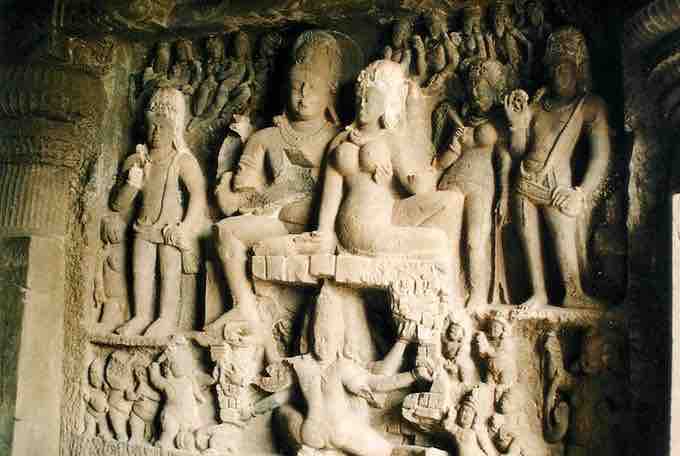Overview: Rock-Cut Architecture
Rock-cut architecture is the practice of creating a structure by carving it out of solid natural rock. In India, the term ‘cave' is often applied in reference to rock-cut architecture; however, it must be distinguished from a naturally-occurring cave, as rock-cut architecture is a highly engineered and elaborately decorated structure. There are more than 1,500 rock-cut temples in India, most of which are religious in nature, adorned with decorative paintings and exquisite stone carvings reflecting a very high level of craftsmanship.
Buddhist rock-cut temples and monasteries were often located near trade routes and these spaces became stopovers and lodging houses for traders. As their endowments grew, rock-cut temple interiors become more and more elaborate and decorated. While many temples, monasteries, and stupas have been destroyed, cave temples are better preserved due to their hidden locations and the fact that they are constructed from stone, a far more durable material than wood, clay, or metal.
India's Rock-Cut Architecture
The Barabar Caves
In India, caves have long been regarded as sacred spaces and were enlarged or entirely man-made for use as temples and monasteries by Buddhist monks and ascetics. The Barabar Caves in Bihar, built in the 3rd century BCE during the Mauryan period, are the oldest examples of Buddhist rock-cut architecture. Credited to Emperor Ashoka, these caves mostly consist of two rooms carved entirely out of granite. The first room, a large rectangular hall, was meant to be a space for worshipers to congregate in, while the second room was a small, domed chamber for worship. This second chamber is thought to have contained small, stupa-like structures, though is empty now.
The Ajanta Caves
The Ajanta Caves in Maharashtra are a group of 30 rock-cut Buddhist temples that spanned 6 centuries, beginning in the 1st century BCE. They are carved into the vertical side of a gorge located in the hills of the Sahyadri mountains. The Ajanta caves are considered masterpieces of Buddhist architecture and contain living and sleeping quarters, kitchens, monastic spaces, shrines, and stupas. Made of brick or excavated from stone, the residences of monks are called viharas, while the cave shrines used for worship are called chaitya grihas.
Similar to the Barabar Caves, the Ajanta Caves are situated close to main trade routes. A great deal of decorative sculpture—intricately carved columns and reliefs, including cornices and pilaster—are found here. A notable trait of rock-cut architecture is the crafting of rock to imitate timbered and carved wood. The Ajanta Caves are home to some very early and well-preserved wall paintings that decorate the walls and ceilings and date from the 2nd century BCE. Executed using tempera technique on smooth surfaces and prepared by the application of plaster, the themes of the paintings are Buddhist and gracefully illustrate the major events of Buddha's life, the Jataka tales, and the various divinities of the Buddhist pantheon.

Ajanta Cave
A great deal of decorative sculpture—intricately carved columns and reliefs, including cornices and pilaster—are found in the Ajanta Caves.
The Ellora Caves
The Ellora caves were built between the 5th and 10th centuries. These caves are made up of twelve Buddhist, seventeen Hindu, and five Jain rock-cut temples, excavated out of the Charanandri hills. The proximity of the temples belonging to different religions demonstrates the religious harmony indicative of the time. Similar to the Barabar and Ajanta caves, the Ellora caves contain many frescoes, reliefs, and shrines, including carvings of the Buddha, bodhisattvas, and saints. In many cases the stone is intricately carved to look like wood.

Ellora Cave
Similar to the Barabar and Ajanta caves, the Ellora caves contain many frescoes, reliefs, and shrines, including carvings of the Buddha, bodhisattvas, and saints.